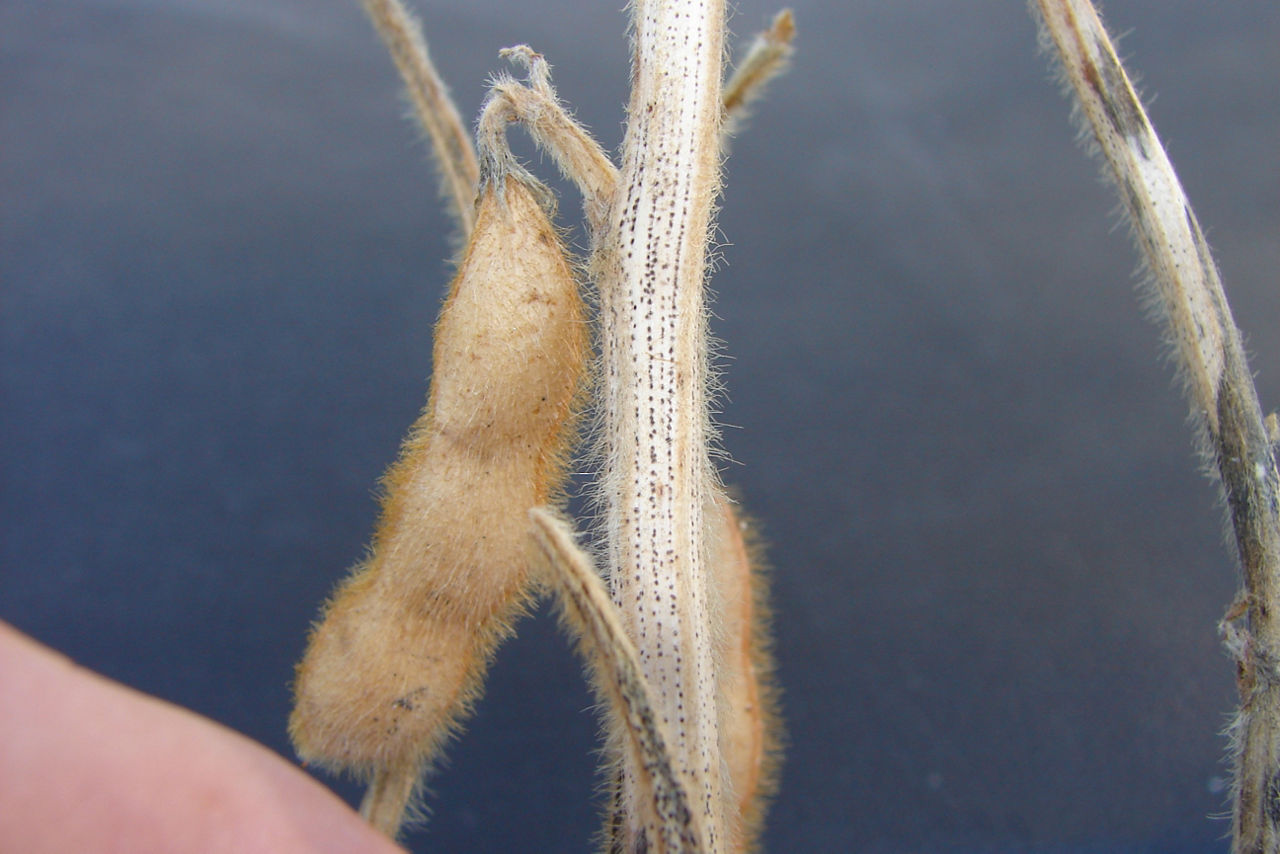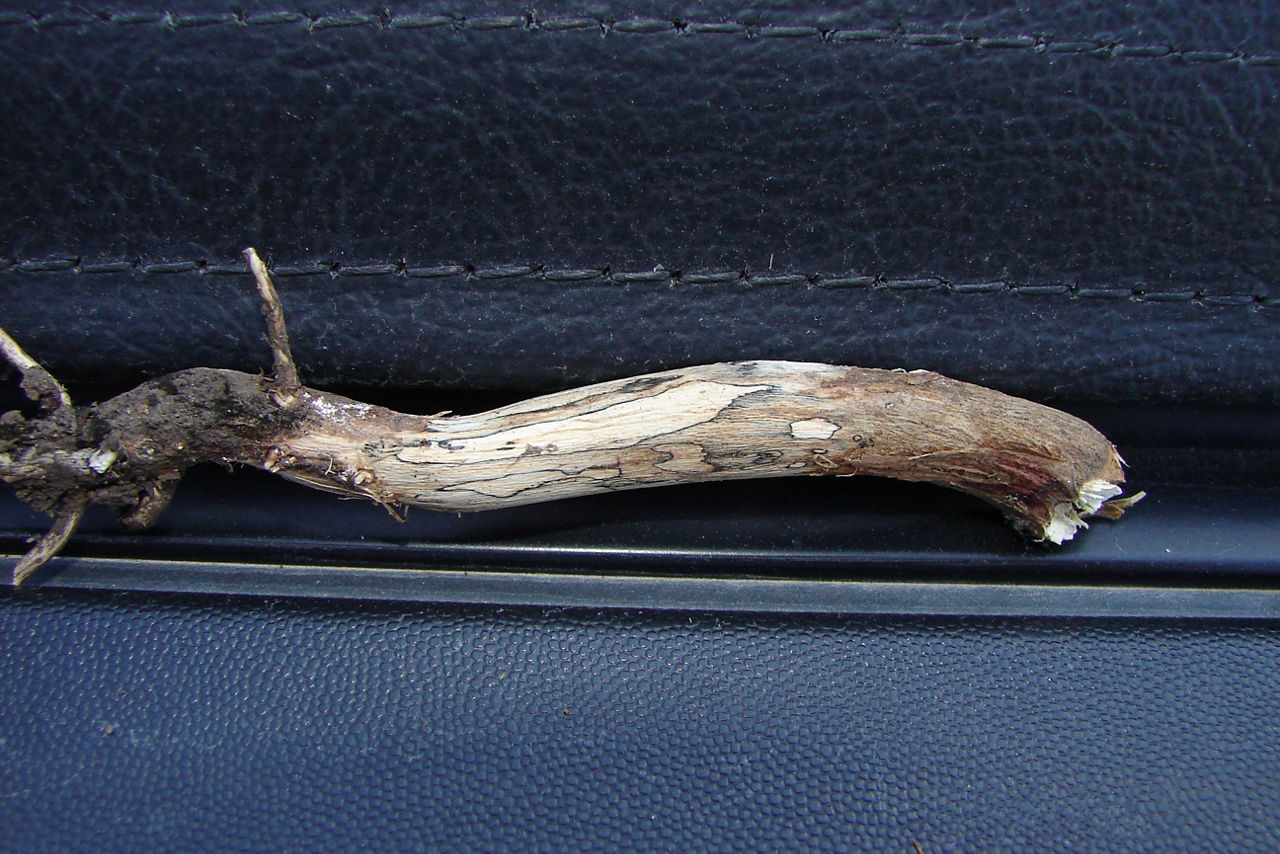Soybean Pod and Stem Blight
June 3, 2024
Pod and stem blight, caused by the fungus Diaporthe sojae, is a common soybean disease in the United States and is frequently found in conjunction with Phomopsis seed decay and Zone lines (Diaporthe longicolla), which can negatively affect soybean seed quality. These diseases function as a complex called the Diaporthe/Phomopsis Disease Complex, which also includes northern stem canker (Diaporthe caulivora) and southern stem canker (Diaporthe aspalathi).
Pod and stem blight is characterized by rows of raised, black specks (pycnidia) on soybean stems (Figure 1). The pycnidia serve as the reproductive structures for this disease and may also be found on soybean pods; however, the pycnidia are usually scattered across the pods instead of being in rows.

Pod and stem blight can be easily confused with anthracnose stem blight (Colletotrichum truncatum) (Figure 2) and saprophytic fungi because each can cause black spots to appear on soybean stems; however, only pod and stem blight expresses the black spots in linear rows. Additionally, saprophytic fungi only colonize dead tissue.

If soybean stems are split or the outside stem tissue is removed, irregular or small circular shapes that are thin and dark may be visible (Figure 3). These shapes are referred to as Zone lines and are associated with Diaporthe species.3

The pod and stem blight fungal pathogen overwinters on soybean residue or in infected seed. Alternate hosts include weeds such as velvetleaf and pigweed spp., and vegetables such as beans, peppers, and tomatoes.1,2
Soybean plant infection by pod and stem blight usually occurs early in the growing season when inoculum is splashed onto the stems, petioles, or leaves, or by planting infected seed. However, the disease typically does not become visible until soybean reproductive stages R6 (full seed) to R8 (full maturity).1 Soybean pods often become infected between soybean reproductive stages R5 (beginning seed) and R6 (full seed).1 It is important to note that all pods on a soybean plant do not necessarily become infected with the disease, and only pods that are infected with the disease can have infected seed.1
Infections, disease development, and yield losses associated with pod and stem blight are typically greatest during warm, wet growing seasons.1 Yield losses occur because of incomplete seed fill due to premature death of soybean plants and from the loss of test weight and seed quality of seeds infected with Phomopsis seed decay.1
Tolerance to infection by pod and stem blight can vary by cultivar, but since seed companies do not typically evaluate their soybean cultivars for tolerance to this disease, it is not practical to use varietal selection as a management practice; however, avoiding products with a known field history of poor tolerance to pod and stem blight is advisable. Activities such as using tillage to bury residue and rotating to a non-host crop like corn or wheat can help reduce the amount of inoculum in a field.
A foliar fungicide application between reproductive stages R3 (beginning pod) and R5 (beginning seed) may reduce the incidence of pod and stem blight. Warm, wet conditions in the fall can promote the incidence of Phomopsis seed decay, but timely harvest can help limit the amount of seed decay that occurs and protect seed quality.1 Soybean seed infected with Phomopsis seed decay can be treated with a fungicide seed treatment, which has been shown to help improve germination and emergence; however, it is unlikely a fungicide seed treatment can improve the germination of severely infected or moldy soybean seed.1
Channel Agronomist
Paul Parcher
Sources
1Mueller, D., Bradley, C., Chilvers, M., Giesler, L., Mathew, F., Smith, D., and Wise, K. 2015. An overview of pod and stem blight and diaporthe seed decay. Crop Protection Network. Soybean Disease Management CPN-1007. https://cropprotectionnetwork.org/publications/an-overview-of-pod-and-stem-blight-and-phomopsis-seed-decay
2Malvick, D. 2018. Pod and stem blight and Phomopsis seed decay on soybean. Soybean Pest Management. University of Minnesota Extension. https://extension.umn.edu/soybean-pest-management/pod-and-stem-blight-and-phomopsis-seed-decay-soybean
3Wise, K., Mueller, D., Bradley, C., Chilvers, M., Freije, A., Giesler, L., Sisson, A., Smith, D., and Tenuta, A. 2016. Soybean stem zone lines: fact and fiction. CPN-1015. Crop Protection Network. https://cropprotectionnetwork.org/publications/soybean-stem-zone-lines-fact-and-fiction
Websites verified 04/05/2024. 1110_392051
Seed Brands & Traits
Crop Protection
Disclaimer
Always read and follow pesticide label directions, insect resistance management requirements (where applicable), and grain marketing and all other stewardship practices.
©2024 Bayer Group. All rights reserved.